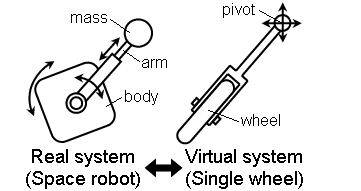
In general, nonholonomic systems, e.g. wheeled vehicles and space robots, have the following characteristics;
Though control of nonholonomic systems is generally a difficult problem for a robot or a computer, there is controversy over whether all nonholonomic systems are difficult to control for a human. A wheel is one of the oldest inventions of humankind and has a long history from ancient times. We know that most people can commonly steer nonholonomic vehicles such as a bicycle, automobile and pushcart, even though some practice is necessary. On the other hand, we may assume that a space robot would be very difficult to operate for a human because we have no chance encounter such systems in our daily life. Thus, the nonholonomic systems include two types, i.e. "easy" systems and "difficult" systems for a human to maneuver.
We propose a human interface to aid in maneuvering nonholonomic systems. We utilize the human ability of handling "easy" nonholonomic systems for the human operation of "difficult" systems. This method would be useful in the realtime teleoperation and manual off-line programming of nonholonomic systems such as space robots. Moreover, the human's adaptability in the control loop enables us to construct a robust system.
In our method, the difficult real system is converted into an easy virtual system using coordinate and input transformation. The input from the human operator to the virtual system is converted into input to the real system, while the state of the real system is converted into that of the virtual system which is displayed to the operator. The operator can then steer the real system feeling as if maneuvering the virtual system.
Let us consider two nonholonomic systems, G and H. The system G is assumed to be easy to handle for a human, while the system H is difficult. The difficult system H is a real system to be controlled. We also assume these two systems are mathematically equivalent and can be converted each other through the state conversion and the input conversion. We use the easy virtual system G as a human interface.
The current state x and the desired state xd of the real system H are converted into those of the virtual system G. Then they are displayed to the human operator. On the other hand, the input u from the human operator to the virtual system G is converted into the input v to the real system H. Then, the operator can handle the real system H feeling as if operating the virtual system G. When the virtual system G reaches the desired state, the real system H also reaches the desired state.


[Video]
Single wheel
Space robot (direct operation)
Space robot (proposed method)